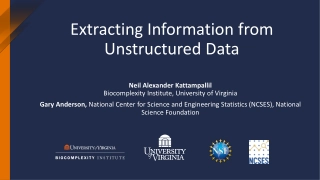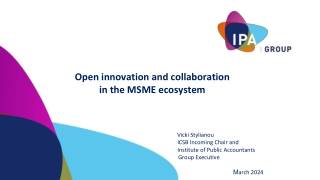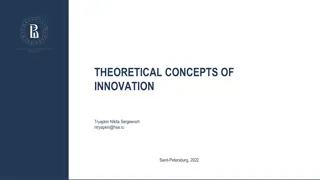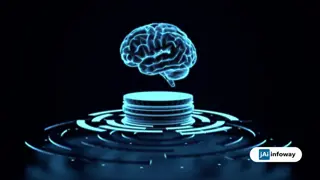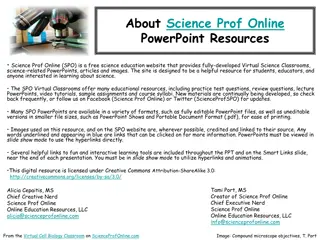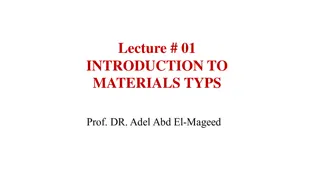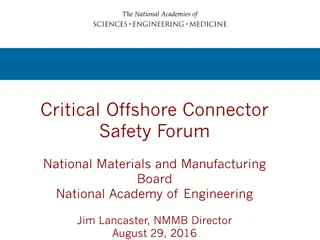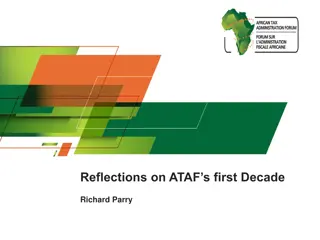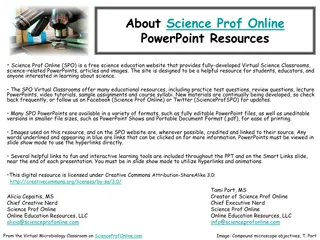Materials Science: Revolutionizing Innovation in the Next Decade
Materials science is poised to be the cornerstone of technological advancements in the next decade, addressing challenges such as clean energy, product innovation, and material supply disruptions. Scientists are leveraging advanced simulation techniques and machine learning to accelerate materials research and drive unprecedented progress. The narrative explores the pivotal contributions of Gerd Ceder and his team in revolutionizing materials discovery and the birth of the open-access Materials Project in 2008.
Download Presentation

Please find below an Image/Link to download the presentation.
The content on the website is provided AS IS for your information and personal use only. It may not be sold, licensed, or shared on other websites without obtaining consent from the author. Download presentation by click this link. If you encounter any issues during the download, it is possible that the publisher has removed the file from their server.
E N D
Presentation Transcript
Materials Science May Be The Most Important Technology Of The Next Decade.
Think of just about any major challenge we will face over the next decade and materials are at the center of it. To build a new clean energy future, we need more efficient solar panels, wind turbines and batteries. Manufacturers need new materials to create more advanced products. We also need to replace materials subject to supply disruptions, like rare earth elements. Traditionally, developing new materials has been a slow, painstaking process. To find the properties they re looking for, researchers would often have to test hundreds or even thousands of materials one by one. That made materials research prohibitively expensive for most industries Yet today, we re in the midst of a materials revolution. Scientists are using powerful simulation techniques, as well as machine learning algorithms, to propel innovation forward at blazing speed and even point them toward possibilities they had never considered. Over the next decade, the rapid advancement in materials science will have a massive impact
In 2005, Gerd Ceder was a Professor of Materials Science at MIT working on computational methods to predict new materials. Traditionally, materials scientists worked mostly through trial and error, working to identify materials that had properties which would be commercially valuable. Gerd was working to automate that process using sophisticated computer models that simulate the physics of materials. Things took a turn when an executive at Duracell, then a division of Procter & Gamble, asked if Ceder could use the methods he was developing to explore possibilities on a large scale to discover and design new materials for alkaline batteries. So he put together a team of a half dozen young guns and formed a company to execute the vision. The first project went well and the team was able to patent a number of new materials that hadn t existed before. Then another company came calling, which led to another project and more after that. Yet despite the initial success, Ceder began to realize that there was a problem. Although the team s projects were successful, the overall impact was limited.
We began to realize were generating all this valuable data and it s being locked away in corporate vaults. We wanted to do something in a more public way, Ceder told me. As luck would have it, it was just then that one of the team members was leaving MIT for family reasons and that chance event would propel the project to new heights.
In 2008, Kristin Perssons husband took a job in California, so she left Ceder s group at MIT and joined Lawrence Berkeley National Laboratory (LBL) as a research scientist. Yet rather than mourn the loss of a key colleague, the team saw the move as an opportunity to shift their work into high gear. At MIT, we pretty much hacked everything together, Ceder explains. It all worked, but it was a bit buggy and would have never scaled beyond our small team. At a National Lab, however, they had the resources to build it out properly and create a platform that could really drive things forward. So Persson hit the ground running, got a small grant and stitched together a team to combine the materials work with the high performance supercomputing done at the lab.
At LBL there were world class computing people, Persson told me. So we began an active collaboration with people that were on the cutting edge of computer science, but didn t know anything about materials and our little band of materials hackers . It was that interdisciplinary collaboration that was really the secret sauce and helped us gain ground quickly. Traditional, materials science could take a class of alloys for use in, say, the auto industry and calculate things like weight vs. tensile strength. There might be a few hundred of those materials in the literature. But with the system they built at LBL, they could calculate thousands. That meant engineers could identify candidate materials exponentially faster, test them in the real world and create better products. Yet again, they felt that the impact of their work was limited. After all, not many engineers from private industry spend time at National Laboratories. Our earlier work convinced us that we were on the cusp of something much bigger, Persson remembers. That s what led them to create The Materials Project, a massive online database that anyone in the world can access.
The Materials Project went online early in 2011 and drew a few thousand people. From there it grew like a virus and today has more than 50,000 users, a number that grows by about 50-100 per day. Yet its impact has become even greater than that. The success of the project caught the attention of Tom Kalil, then Deputy Director at the White House Office of Science and Technology Policy, who saw the potential to create a much wider initiative. In the summer of 2011, the Obama administration announced the Materials Genome Initiative (MGI) to coordinate work across agencies such as the Department of Energy, NASA, the Department of Energy and others to expand and complement the work being done at LBL. These efforts, taken together, are creating a revolution in materials science and the impacts are just beginning to be felt by private industry.
The MGI is based on three basic pillars. The first is computational approaches that can accurately predict materials properties, like the ones Gerd Ceder s team pioneered. The second is high throughput experimentation to expand materials libraries and the third are programs that mine existing materials in the scientific literature and promote the sharing of materials data. For example, one project applied machine learning algorithms to experimental materials data to identify forms of a super strong alloy called metallic glass. While scientists have long recognized its value as an alternative to steel and as a protective coating, it is so rare that relatively few forms of it were known. Using the new methods, however, researchers were able to perform the work 200 times faster and identify 20,000 in a single year!
Thomas Edison famously remarked that if he tried 10,000 experiments that failed, he didn t actually consider it a failure, but found 10,000 things that didn t work. That s true, but it s also incredibly tedious, time consuming and expensive. The new methods, however, have the potential to automate those 10,000 failures, which is creating a revolution in materials science. For example, at the Joint Center for Energy Storage Research (JCESR), a US government initiative to create the next generation of advanced batteries, the major challenge now is not so much to identify potential battery chemistries, but that the materials to make those chemistries work don t exist yet. Historically, that would have been an insurmountable problem, but not anymore. Using high performance computing simulations, materials genomes and other techniques that have been developed over the last decade or so, we can often eliminate as much as 99% of the possibilities that won t work, George Crabtree, Director at JCESR told me. That means we can focus our efforts on the remaining 1% that may have serious potential, and we can advance much farther, much faster for far less money.
Using high performance computing simulations, materials genomes and other techniques that have been developed over the last decade or so, we can often eliminate as much as 99% of the possibilities that won t work, George Crabtree, Director at JCESR told me. That means we can focus our efforts on the remaining 1% that may have serious potential, and we can advance much farther, much faster for far less money. The work is also quickly making an impact on Industry. Greg Mulholland, President of Citrine Informatics, a firm that applies machine learning to materials development, told me, We ve seen a huge broadening of companies and industries that are contacting us and a new sense of urgency. For companies that historically invested in materials research, they want everything yesterday. For others that haven t, they are racing to get up to speed. Jim Warren, a Director at the Materials Genome Initiative, thinks that is just the start. When you can discover new materials for hundreds of thousands or millions dollars rather than tens or hundreds of millions you are going to see a vast expansion of use cases and industries that benefit, he told me. .
As we have learned from the digital revolution, any time you get a 10x improvement in efficiency, you end up with a transformative commercial impact. Just about everybody I ve talked to working in materials thinks that pace of advancement is easily achievable over the next decade. Welcome to the materials revolution.


